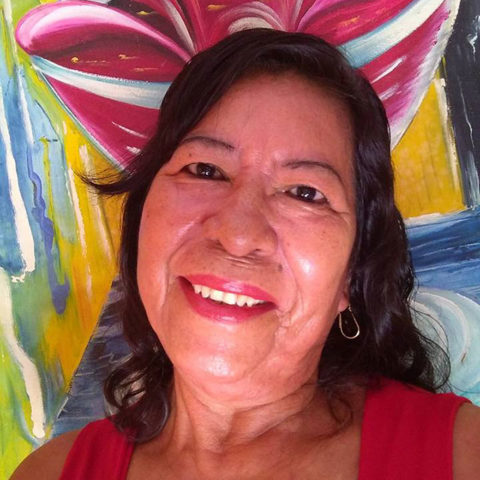
Valdenora’s Story: Amazonian trailblazer fighting for equality
Ahead of World Leprosy Day 2019, we meet inspiring people fighting against the stigma and discrimination associated with leprosy. From Brazil, this is Valdenora’s remarkable story of survival, recovery and advocacy.
Valdenora da Cruz Rodrigues was born on May 24, 1960 in the town of Arauiri, in the municipality of Tefé, Amazonas. Fifteen days after her birth, her biological mother died of Tuberculosis. After her mother’s death, Valdenora was delivered by her father to the couple who had baptized her. According to her adoptive parents, she was a very sick child, compromised by the lack of nutritional breastfeeding. When her adoptive mother was pregnant with her first child, Valdenora was taken care of by an uncle who had leprosy. At the age of 8, the first signs of her leprosy began to appear: spots, pains in the body, and edema in the hands, feet and ears.
At this time, it was common for people from the interior of the country and from the riverside communities to seek help through medicinal plants, healers and spiritual support. Her relatives used this type of treatment, but they were not successful. Children at the school where Valdenora studied, and where her adoptive mother was a teacher, began to isolate her when they noticed her signs of leprosy. Then, some parents pulled their children out of school. Because this was the only school in the community, Valdenora’s mother soon lost her job as a result of her daughter’s leprosy.
One day Valdenora’s parents took her to a doctor in the city of Tefé, which was 4 hours away by boat (they had no motor boat). After four visits to the city, she was diagnosed with leprosy in 1969 and the doctors ordered her hospitalization in the Antonio Aleixo Colony in Manaus. Her family mobilized to get her sandals (she had never worn any footwear) and clothes (because her clothes were made of sugar-bag fabric) so she could travel to the capital.
When her father took her to board the boat at Canoa, she was not allowed to travel with the other passengers, as they feared her leprosy. She was instead placed in a canoe, tied in tow to the boat. To protect her from the sun and the rain, her father wove a cover for the canoe.
The voyage to Manaus, where she would be hospitalized in the colony, took two long days and nights, during which the 9 year old Valdenora was unable to feed. She recalls being scared, alone and in tears. The years in the colony were very difficult, because as a child she did not understand why she was hospitalized and isolated from her family. In 1976, at age 16, she was discharged from the hospital and returned to her community; however, after a year she returned to the colony, after feeling stigmatized by the people of the community who treated her as the sick girl who returned. In 1978, the colony was decommissioned due to the ordinance that ended segregation for people affected by leprosy. In 1981, aged 21, she was hired by the Health Department of the State of Amazonas as a nursing assistant, then learned to be a midwife – a common traditional role for women in the community. However, before being hired by the state as a midwife, she suffered prejudice in the company where she worked, for having been a resident of the colony hospital.
In that same year, she started living with Mr. Edigilson Barroncas, her companion until today. In that same year, along with other comrades she became involved in the social movement and in 1982 they founded MORHAN in Manaus – a Brazilian NGO for the rights of people affected by leprosy. On International Women’s Day in 1984 she was honoured by the Municipal Chamber of São Bernardo do Campo in the State of São Paulo.
In 1985, she was affected by a recurrence of leprosy, accompanied by a reaction. The development of a claw in her hands and feet caused her to experience revolt, indignation and disappointment, because at the age of 26 she was now prevented her from doing what she liked best: delivering children.
After much struggle, she was one of the first people in her state to achieve disability retirement after being affected by leprosy. In 1994, she and her partner adopted their only son. Adopting her son was one of her greatest difficulties in coping with stigma, because her son suffered a lot of prejudice as the child of people affected by leprosy. This hurt Valdenora and upset her a lot. Both she and her husband were prevented from attending parent-teacher meetings in the schools where their son studied.
Today, Valdenora’s son continues to help his parents advocate for the rights of people affected by leprosy. In 1999, she was elected to the State Health Council of Amazonas. In 2005, she was elected to MORHAN’s national board of directors and in 2006, she became a Board Member of the National Council for the Rights of Persons with Disabilities.
At 58, Valdenora is still a fighter for the rights of people affected by leprosy, women and people with disabilities in Brazil. She is a remarkable person for her commitment, strength and all that she has overcome.
Story provided by MORHAN.